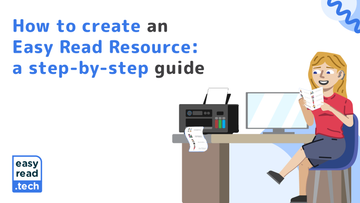How to create an Easy Read resource: a step-by-step guide

How to create an Easy Read resource: a step-by-step guide
Creating your own Easy Read documents is a perfect way for organisations with the appropriate resourcing to show a genuine commitment to accessibility of information for people with intellectual or learning disabilities, cognitive decline, or low literacy levels.
easyread.tech have narrowed it down to three important facets to create a clean and simple Easy Read resource: simple text, minimalistic layout and images.
Here are 7 steps to guide you and your organisation in developing your own Easy Read resources!
1. Consider your target audience
Like with any written text, it is important to consider your text’s intended audience. In Easy Read context, this will shape how simplified language should be, what information is included and the cultural and age factors of any character illustrations. Consider factors like:
- Literacy levels
- Cognitive ability
- Age
- Cultural background
2. Consider the key information in your document
It is important to read your source document and pick out only the key points of information that will contribute to the main message of your text. Ask yourself what you want your reader to gain and learn from reading the Easy Read text. This is important in ensuring your content is engaging and manageable to digest, and also fulfils its intended purpose.
3. Use a logical structure in your text
Organise your content in a logical and easy-to-follow structure.
Our Easy Read conversion process involves starting the document with an explanation of:
- Who wrote the document
- The Easy Read format
- ‘Hard words’ are and how to identify them
- How the document can be read
Headings are also an essential part of the Easy Read format and help to break down the content into cohesive sections.
4. Utilise simple language
Easy Read consistently uses simple words and grammar, reading to a year 3-5 reading level. Easy Read text avoids the overuse of jargon and technical terms, instead opting for language that is easy to understand.
If technical words are necessary to include, a good practice is to provide a simple definition of them.
Read our article on ‘The Art of Simplification: Tips for Writing in Plain Language’ here.
5. Make your document design user-friendly
The visual aspects of your document are just as important as the written ones.
The Easy Read format is known for its minimalistic, clean layout, that includes ample white space, short paragraphs, consistent sans serif font and generous line spacing.
A well-designed document that doesn’t aim to do too much or overwhelm the reader enhances the overall user experience.

6. Include images that add context to your text
Images are used in the Easy Read format to support the text. It is important to choose images that are contextually relevant and relatable to your reader, simple and not too abstract, and contribute directly to the reader’s comprehension of the paragraph next to it.
Easyread.tech’s collection of over 600 images is a valuable one-stop-shop for consistent, inclusive and locally relevant illustrations to use in your next Easy Read document, creating an easy to follow story.
7. Conduct user testing before launch
Before finalising your Easy Read document, it is optimal to test your document with members of your target audience. This will give you an indicator of your text’s readability, comprehension, layout and overall user experience.
It is always important to ask the right questions to get the most productive feedback.
Some considerations to keep in mind when conducting user testing include:
- Any background information that should be provided to your test audience
- Any potential triggers in your text
- Ensuring a comfortable environment where your audience feels empowered to criticise.
It is also important to pay your test audience; they are providing a service and so should be remunerated as such.
By following these steps, you can create an Easy Read document that effectively communicates key information to a diverse audience, promoting inclusivity and accessibility in written communication and resourcing.
Learn more about our mission to improve accessible information, and how you can get started developing Easy Read resources today.
